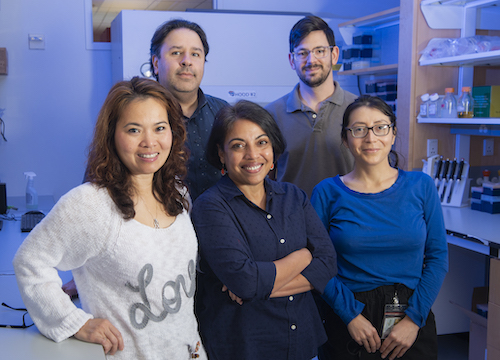Deployed military personnel frequently face numerous health and safety hazards as part of their daily activities in service to their nation. Among many dangers is the possibility of encountering hemorrhagic fever viruses (HFVs), a group of highly infectious pathogens such as the Ebola virus. Many of these diseases do not currently have effective therapeutics and can be prevalent in areas where service members are deployed, putting them at risk of exposure.

George Mason University infectious disease researcher Aarthi Narayanan has partnered with the United States Army Medical Research Institute of Infectious Diseases (USAMRIID) and Cyclica, a biotechnology company based in Canada, to identify potential broad-spectrum therapeutics for illnesses triggered by HFVs and similar pathogens.
“Tackling this challenge requires a multidisciplinary approach,” said Narayanan, who is an associate professor in the College of Science and a faculty member in the Department of Biology and the Institute for Biohealth Innovation. “With the support of a $3.2M grant from the Department of Defense, our team will be working to address the mechanisms by which some HFVs cause disease and using cutting-edge technology to keep military personnel and those they serve safe.”
USAMRIID and Mason will start by generating samples through exposure studies. Biosafety Level 3 pathogens will be examined at Mason’s Biomedical Research Laboratory, while USAMRIID will work with Biosafety Level 4 agents.
Mason will use its reverse-phase protein microarray (RPPA) to understand how cells communicate with other cells in a host’s response to infection. Specifically, the team is interested in changes to the cells that line blood vessels, also known as endothelial cells. In many cases, the viruses that will be studied lead to damage to endothelial cells as a result of hemorrhage, leading to severe illness or death.
Cyclica has extensive knowledge in machine learning and will help Mason develop artificial intelligence models. Using data from the RPPA, the models will search for druggable targets that could interrupt the host response.
Any encouraging findings will be tested with an organ-on-chip (OoC) platform, an emerging technology that mimics human organ physiology on a microfluidic chip. Since OoCs are able to simulate organ systems, they are more informative than traditional cell cultures, and they increase the likelihood that treatment strategies will work successfully in animal models and, eventually, in humans.
“This project allows us to combine unique assets of the university with outside expertise,” said Narayanan. “Collaboration opens doors for us and creates new opportunities that may not be available to the team if we had performed the studies individually.”
Narayanan's ultimate goal is to identify two or three broad-spectrum small molecule drugs that could be used for the next stage of development. The small molecules’ size enables them to easily enter cells and reach targets that other drugs struggle to engage. Many small molecule drugs are already FDA cleared or approved for other applications; the team hopes that some of them could be brought to market as countermeasures for HFVs. Repurposed therapeutics can be available to the medical community sooner than new medications, as they have already gone through the FDA review process.
With hospitals quickly becoming overrun during COVID-19, Narayanan also sees this research as a chance to prepare for a future pandemic. Due to biological agents’ volatile nature, there is often little time to establish diagnostic capabilities and assess remedies. Having broad-spectrum therapeutics available as a tool to mitigate host response means more time could be dedicated to creating accurate diagnostics and administering treatments that will target the pathogen.
Additionally, Narayanan said the project presents a great opportunity for Mason graduate students on the team to gain experience in a variety of fields, ranging from disease pathology to proteomics and bioinformatics.
“Impactful, experiential learning opportunities like this truly prepare Mason Science graduate students for exciting professional trajectories,” said Fernando Miralles-Wilhelm, dean of the College of Science. “Our Mason Science researchers pride themselves on bold, creative work with innovative strategic partners to address grand global challenges.”
While the task may seem daunting to some, Narayanan is eager to begin. She is confident that the team will uncover groundbreaking solutions that will protect military personnel and serve the broader civilian community.
“My team members are extremely remarkable individuals who value saving as many lives as possible,” said Narayanan. “Together, I am positive that we will be able to make great strides in both military and public health.”
About the U.S. Army Medical Research Institute of Infectious Diseases
Since 1969, USAMRIID has provided leading-edge medical capabilities to deter and defend against current and emerging biological threat agents. The institute is the only laboratory in the Department of Defense equipped to safely study highly hazardous viruses requiring maximum containment at Biosafety Level 4. Research conducted at USAMRIID leads to vaccines, drugs, diagnostics, and training programs that protect both warfighters and civilians. The institute's unique science and technology base serves not only to address current threats to our Armed Forces but is an essential element in the medical response to any future biological threats that may confront our nation. For more information, visit usamriid.health.mil.
